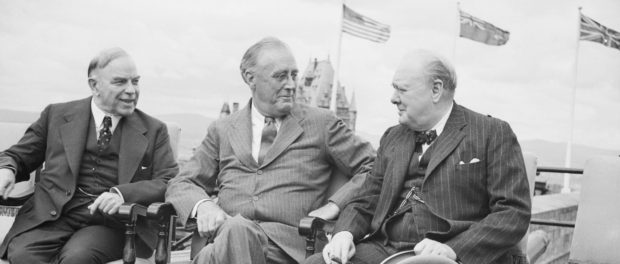1943: Montreal and the Atomic Bomb & Other Quebec Curios
Part of "Shadows and Revolution", 1900-1960
 Canadian Prime Minister Mackenzie King, with President Franklin D Roosevelt, and Winston Churchill during the Quebec Conference, 18 August 1943. Credit: Imperial War Museum, catalogue number: H 32129
Canadian Prime Minister Mackenzie King, with President Franklin D Roosevelt, and Winston Churchill during the Quebec Conference, 18 August 1943. Credit: Imperial War Museum, catalogue number: H 32129
The race to create an atomic bomb started shortly after World War II began, with the United States spearheading the Manhattan Project. The USSR, acting on intelligence that the United States was starting research on creating a nuclear bomb, started conducting their own tests. It would be the United States, however, that would succeed in creating the first atomic bomb in July of 1945, whose powers were unleashed on Japan that same August. While the Manhattan Project, led by brilliant minds such as Robert Oppenheimer, were busy at work, they were also getting help from an unlikely source: Québec.
As the war marched on, researchers at Cambridge had determined what type of uranium would need to be used and how much of it would be needed to make a bomb. Since many other British physicists and scientists were involved in other projects involving other materials, the team working on uranium thought about moving to the United States, where significant advances on a uranium bomb had already been done. The Americans, however, were insecure due to the fact that the Cambridge team, composed of British men but also refugees from Europe, could compromise the security of their own research, and proposed instead that the location be Canada.
Scientists would initially work in what used to be a residency building at McGill University, but towards the end of 1942, they moved into the west wing of the Université de Montréal’s main building, now Pavillon Roger-Gaudry. After the move, the team grew to over three hundred people, mostly English-speaking. Out of the whole group, the only French-speaking member was Pierre Demers, who was responsible for a technique that would produce a special isotope of uranium that would be (and still is) used as nuclear fuel. The research done by the scientists in Montréal was based on heavy water, a source of energy that French scientists had smuggled to the United Kingdom, then to Canada. Heavy water was one of the components that was able to react with other ingredients to produce plutonium, traces of which can be found in uranium but would have to be produced in much larger quantities than those found naturally in order to create a bomb.
Despite the scientists’ advances, most Canadians and Quebeckers were unaware of the project until its completion. In 1943, when communications between Canada and the States became increasingly strained due to security measures. The main leaders involved in the process, Winston Churchill and Franklin Roosevelt, met in Québec with Prime Minister Mackenzie King to sign what was to be known as the Quebec Agreement, another secret agreement unknown to most Canadians at the time, in which the United Kingdom and the United States agreed that any nuclear developments would not be used against each other. Following the signature of this document, most of the British scientists that had come to Montréal moved to Los Alamos, where the Manhattan Project was based.
In accordance with the provisions of the Quebec Agreement, the United States had to ask permission from the United Kingdom in order to send the atom bombs to Japan to do their disastrous work. The bombings of Hiroshima and Nagasaki, believed to be one amongst many factors in Japan’s surrender, caused the deaths of over 129 000 people, most of who were civilians.





